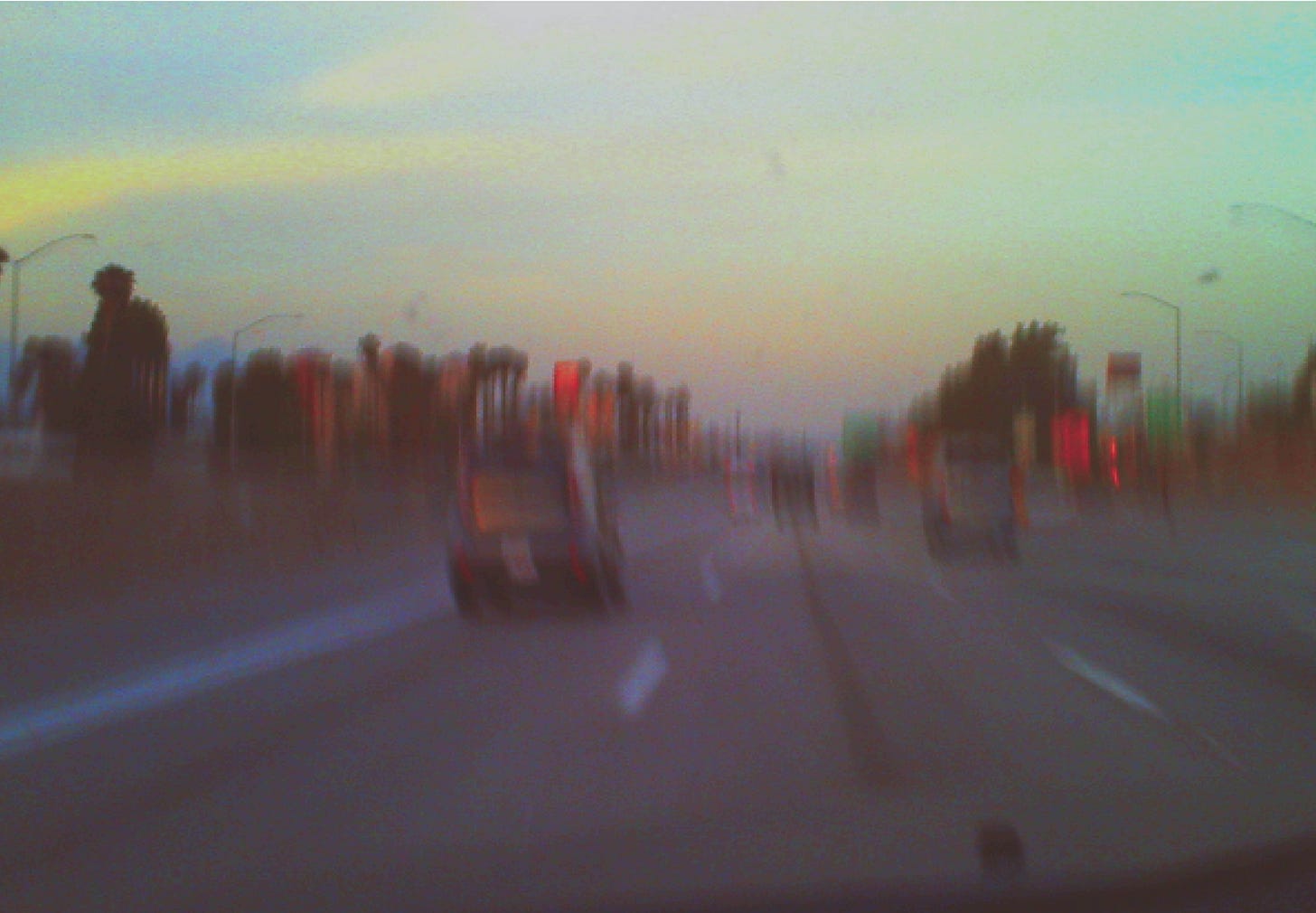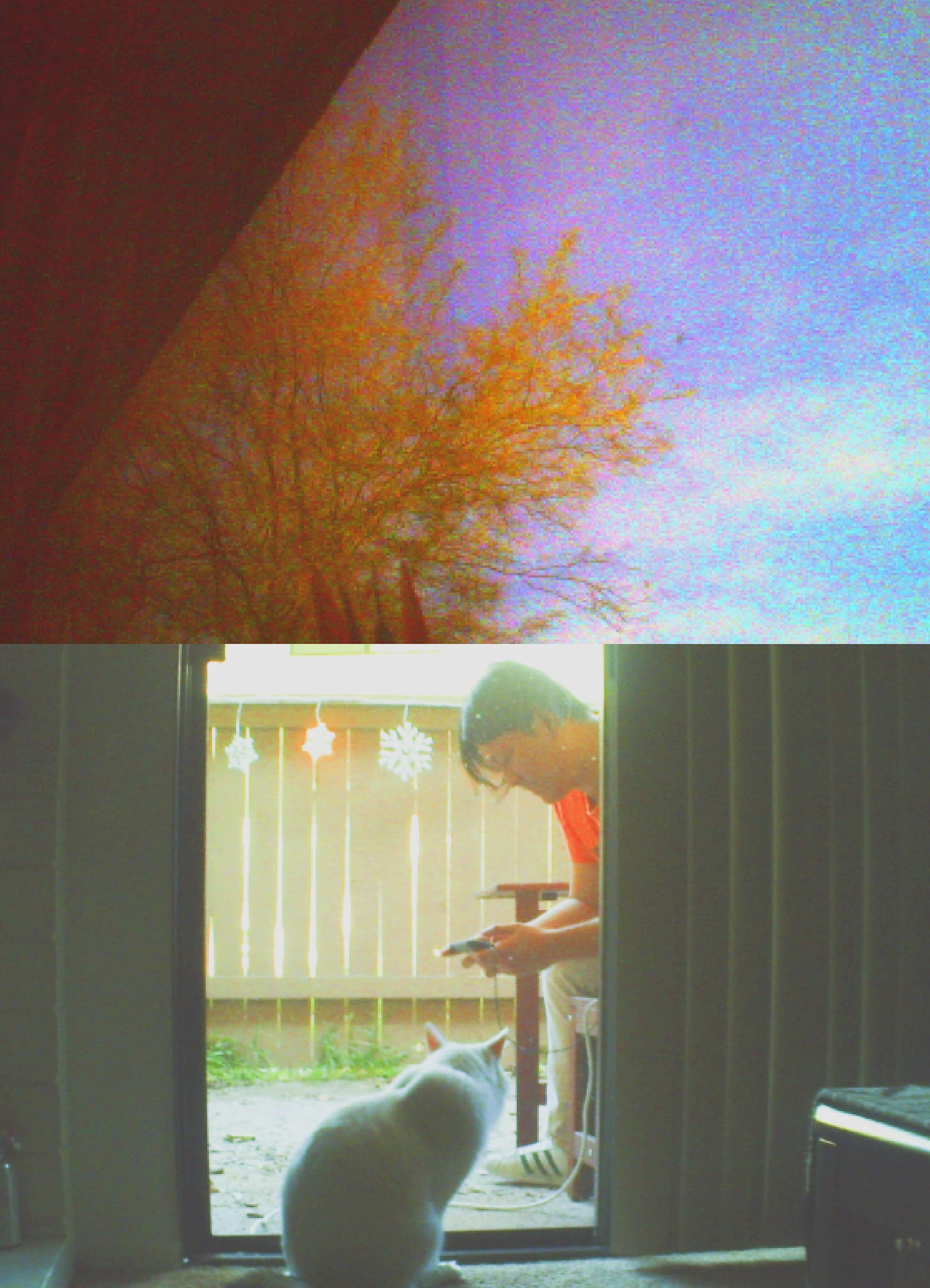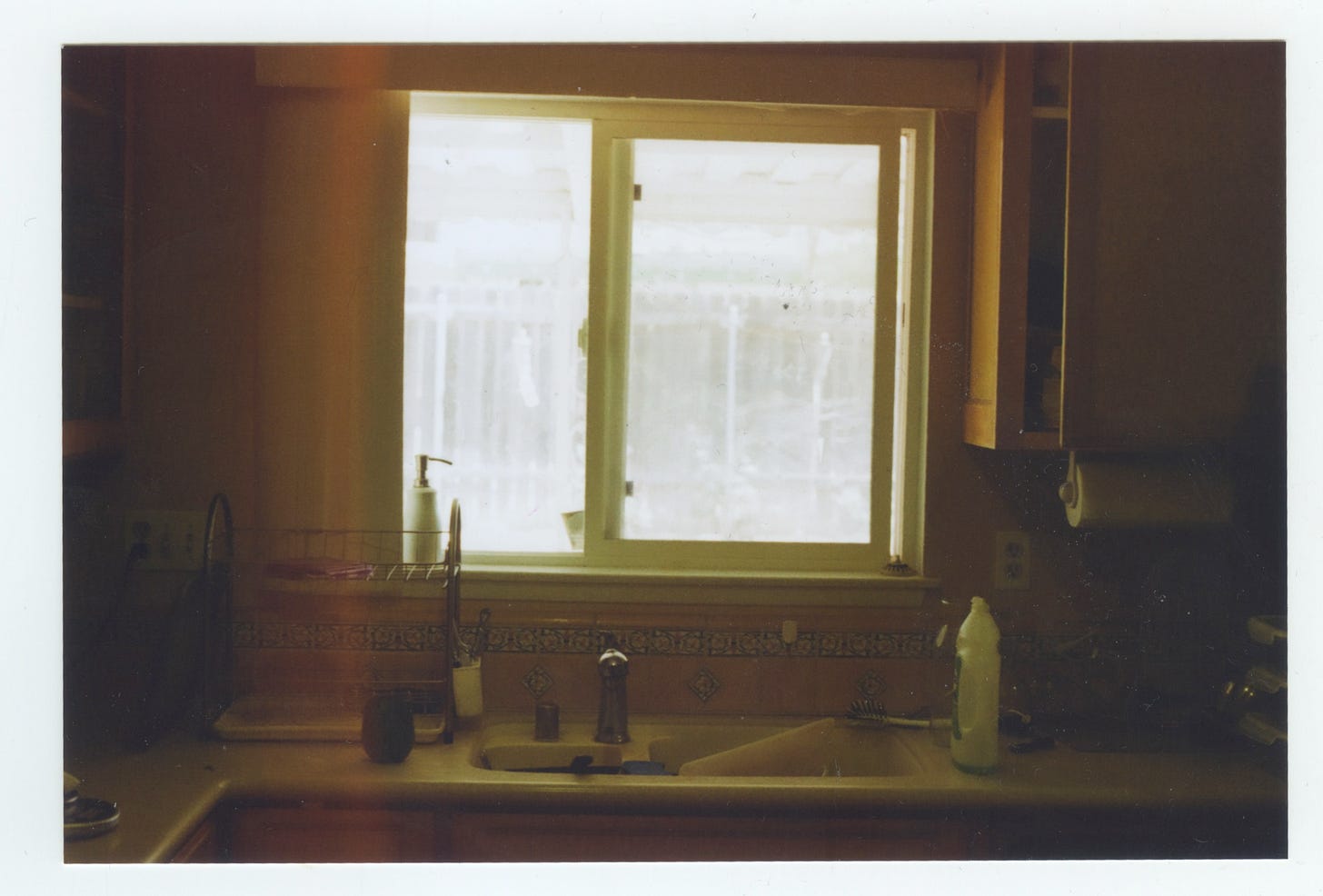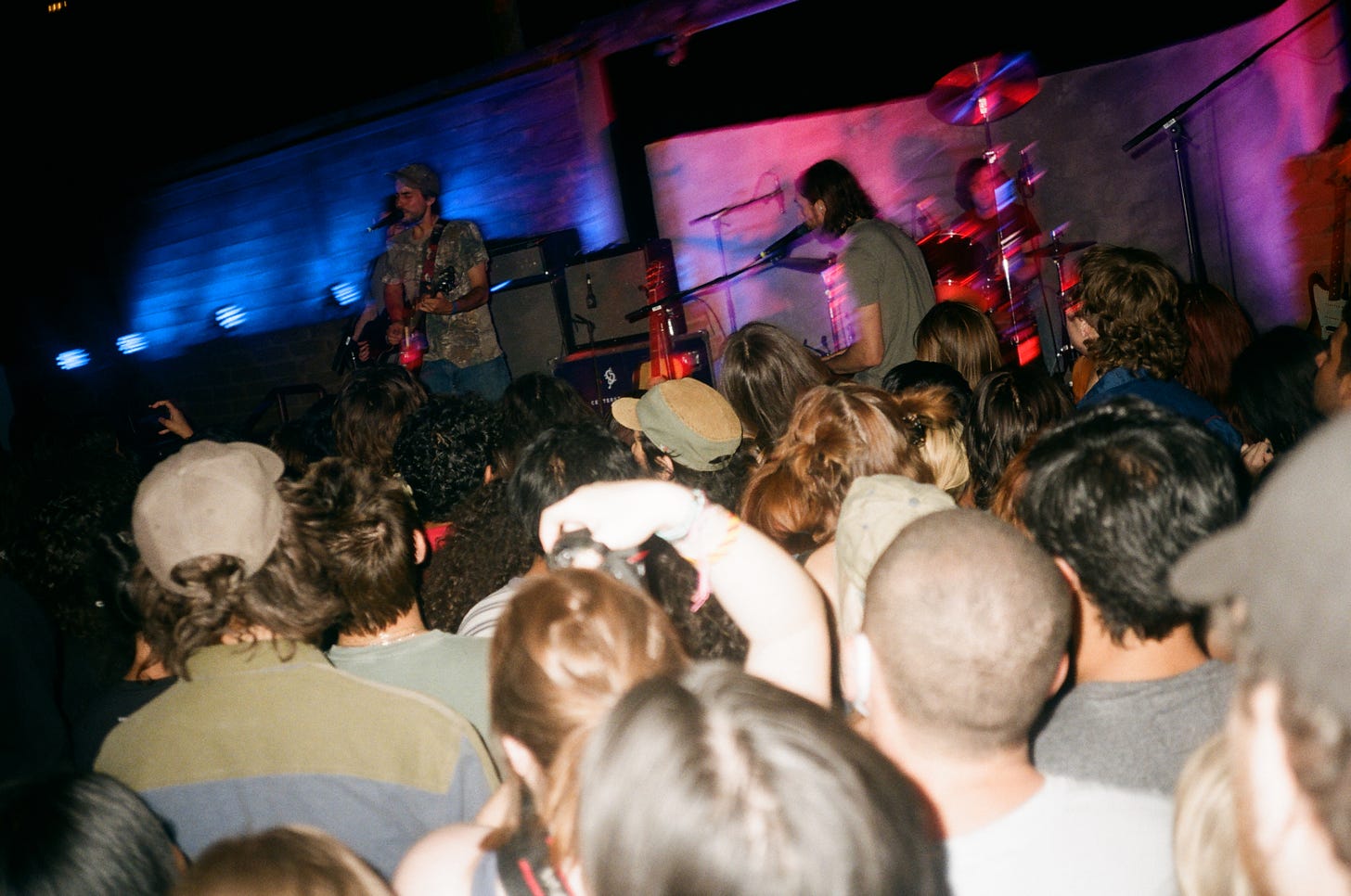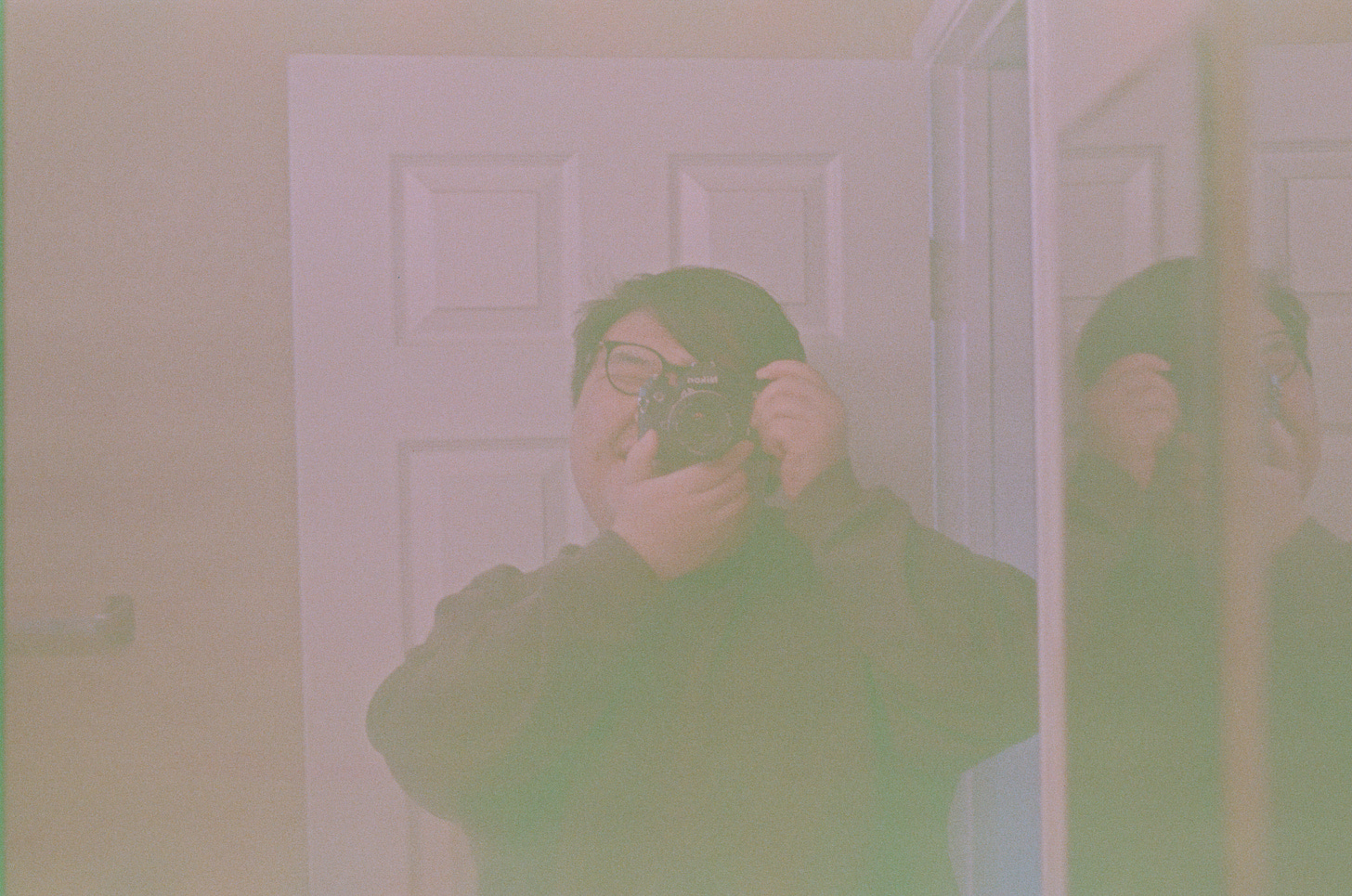Tomorrow Is a Long Time
Mental Health and Art-Making
Hello! This is an essay I wrote for my zine, “EARLIER/TODAY,” set to be released sometime this week. I originally had the idea and worked on the book in 2022 before abandoning it completely.
This is a jagged, sorta confessional piece about that experience.
2016/
The first camera I bought for myself was a Digital Harinezumi 2.0. Plasticky and red, the toy camera came shipped from a Japanese merchant on eBay. I had read that Terrence Malick and Harmony Korine shot footage on the Harinezumi (for their films, To the Wonder and Spring Breakers, respectively).
With a sensor as small as a pinky nail, the kind of image the camera produces is intentionally imperfect. However, instead of trying to compensate for the compression and smooth out its fuzz, it does the opposite. The Harinezumi leans into the noise and oversaturates itself instead. Rainbow-colored grain litters the footage, not unlike a Seurat painting.
I got the camera in the summer between my first and second years of college. In 2016, I was 19 and a bad student. Avoiding coursework, I opted to immerse myself in my true passion at the time: filmmaking. Fixated by the transportive, sensorial experience film provides, I wanted to learn as much as I could about it — what each button and dial did on a camera, how to pace and structure a screenplay, how to talk to actors. I was self-taught. I was excited. I had a secret.
One of the first filmmaking concepts I learned about, that really resonated with me, was the Kuleshov Effect. Closer to a magic trick, the effect plays out in memory like this:
We open on a tight, close-up of a woman’s face. She is relaxed, almost expressionless. Cut to black.
Next, we see a ship leaving harbor, the camera at a distance. In my memory, it is a large ship. No one is on the docks. The motion is simple — the ship, once stationary, moves away from us and into the ocean. After another cut to black, our eyes reset again.
The images are then shown in sequence: the woman’s face followed by the ship leaving, then back to the woman’s face again. Suddenly, a story forms.
The once-seemingly neutral face is painted with whatever emotion we, the audience, project onto it. How does she feel about the ship leaving? Happy? Sad? What is she hiding? What does she feel? The images begin talking, creating meaning and context with each other.
2017/
I had my first panic attack in the winter of this year. It was at a house party I threw with a couple of friends I was living with. We timed it to begin after a huge concert on campus (which we did not attend), and for some reason, we made the invitation public (my idea). In retrospect, I wanted to throw a party, because I wanted attention. It was an act of beckoning. Come here, come inside — see me. Look at how cool and interesting all this is/I am. I have nothing to hide.
As the first batch of complete strangers wandered in, my feet felt like they were encased in concrete. The cones in my eyes went in and out of focus. I felt my chest caving in on itself, and I began shivering. The room, lit by color-changing LEDs, shrank into itself. My fingers and toes felt like they were attacked by insects. The ground was wet.
In the following years, waves of anxiety and depression crashed in-and-out of each other like the sea under a storm. The first years were the worst. Ashamed of my pain and unable to communicate what I was going through, I distanced myself through vice, disappearing into distraction. Getting high and watching movies and online videos for long stretches of time, listening to podcasts over loudspeakers. Missing classes, over-eating, under-eating; text messages went unread for months. The sink spilled over with dirty dishes.
I grew estranged from my life, and with it, my perception of time. In rare moments of clarity, my mind attacked itself with thoughts of insecurity and over-estimations. Fear everywhere. If I tried looking forward, towards the future, I saw only a dead end. A version of myself that was unable to change, my problems worsening, spiraling, the world burning. If I tried looking backwards, the past would shroud itself in dusk. Memories in pointillistic fragments, years blurred into each other. Everything was fuzzy like a Seurat painting.
2020/
It is difficult to describe the summer the world went into lockdown. I scribble in my notebook, trying to find the right words. The word “disease” is too obvious and too broad. “Death” was a part of it. “Selfishness” rose. “Hiding”? Nothing suffices. Staying in place with an abundance of interiority overwhelmed me, and my depression worsened. I was holed up inside reading about and watching the outside, through my computer and phone. Story after story, devastation after devastation, distraction after distraction.
In this fugue state, a line was drawn inside my mind. On one side, there were the “Before-Times,” an amalgamation of the world I knew. A world where I was ignorant yet somewhat blissful in my unawareness. I was a child in the Before-Times. Anything I knew of the world lived there. On the other side of the line, there was the the pandemic. This unknown presented itself dire and seemed, at its worst, fascist and unavailable.
2025/
In the present, I want to say outright how irrational depression-thinking can get. . The worst part of this line-drawing-kind-of-thinking is its myopia. A dramatic, unnuanced, and solipsistic myopia.
But it felt/feels real when I spiral. It felt like I was crossing a threshold, because I couldn’t make out what was on the other side. Depression, a grease fire, obscures all but its self, its own blinding blaze.
2021/
Six months after we received our vaccines, several friends1 and I drove out to the desert for a concert. We arrived at the venue, Pappy and Harriets, early and ate dinner. Because this was our first show together in almost two years, our feelings were heightened. We took our masks off when we ate, but we put them back on when we walked to the bar. The desert heat, like a blanket, added a layer of sweat onto everything.
We attended plenty of concerts before the pandemic. It was how we spliced each other into our lives. Driving to the venue and finding the right spot to stand, dancing and singing, then going out to grab chicken tenders after a show. Quietly reminiscing about the entire night on the drive back home.
As the sun sank, the show began. The artist, Alex G, and his band performed. The crowd was antsy, full of energy. As soon as the instruments were plugged into their amps, the entire pit squeezed into itself, like a lung inhaling. My nervous system flared up again. After more than a year of social distancing, here I was, pressed into the bodies of strangers. It was an insane way to acclimate to the outside world after being inside for so long.
People moshed. People danced. People yelled at the band to play the song “Powerful Man” (maybe a little too aggressively). We were outside, yet the darkness created a room.
2022/
If I had to examine these years, when I wasn’t occupied with depression or bowled over by anxiety, I was looking at the world through the viewfinder of a camera. Throughout college, I made short films of my friends in the vein of early YouTube vlogs and DIY skate videos we’d watch in our living room. We loitered in each other’s lives: sitting around tables, eating food, drinking, or hiking around a forest. And I set these movies to music. Glorious iPhone video, footage taken from the Harinezumi, DV, a cinema camera Farhan held on his shoulders — through recorded image, I remembered my life and the people I loved.
A year after lockdown ended, I began rewatching and unearthing old photos and videos from that time. During a writing workshop with some friends, I put together a fiction of how I felt in the present using images from the past, taken directly from the Harinezumi. It was my attempt to piece together meaning, trying to explain how I felt at the concert in the desert. How strange and mutable our world is and has always been.
My friend Allen gave me the gift that became the title of the zine, “Earlier/Today”.
2023/
I tried publishing this project. I printed everything out. I made plans. I was ready. Then, irrationality appeared again. Depression dissuaded me with the same arguments it always made. A box of the zines sat at my feet for another two years.
2025/
After nine years of owning the camera, eight years of panic attacks, and four years of driving out to the desert, I feel at peace releasing this project. This is 2021 told through the images of 2016, finally released in 2025.
Memory is a narrative we continuously set and break ad infinitum. I look at various times in my life, and whenever I felt shame, I piled onto it. Today, I greet the younger versions of myself with patience.
It has become a kind of a loop. I get hurt, come in and save myself, forget about it, then do it all over again.
EARLIER/TODAY will be out this week. I’ll send an email blast with a nice link to buy the zine!
Same friends who helped me throw the party in 2017. They’re still some of my closest, favorite people on earth.



